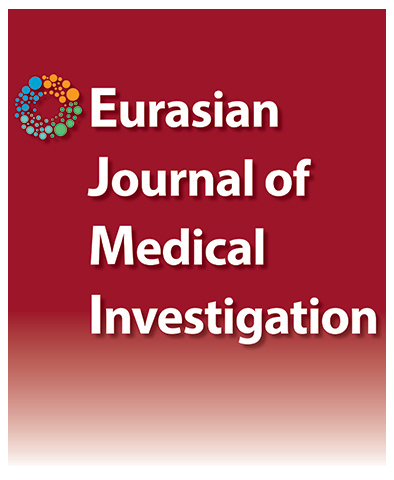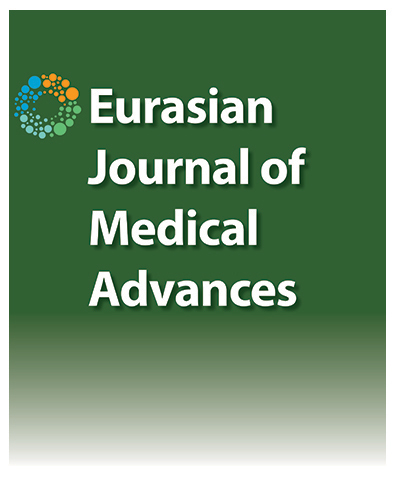Volume: 3 Issue: 1 - 2023
| REVIEW | |
| 1. | Occupational Eye Diseases Yasemin Yurt doi: 10.14744/ejma.2023.03521 Pages 1 - 4 Depending on the person’s working, various disorders related to the eye can occur. Depending on the work, cataracts, macular degeneration, retinal detachment, allergic conjunctivitis can be seen. Welders, computer and other users with visual displays, jewelery makers, fluoroscopy and cardiac catheterizers, radiology technicians are at risk for cataracts. Allergic conjunctivitis due to allergens such as organic dusts, chemicals, etc., which are exposed in the working environment, may occur. Employees should perform necessary medical examinations and tests according to the nature of the work and the working environment. If the work done and the environment are risky for eye disease, necessary precautions should be taken. The worker should also be examined before starting work, and periodic eye examinations should be done after starting work. |
| 2. | Treatment in PFAPA Syndrome: A Review Ayşe Aydınoğlu doi: 10.14744/ejma.2022.47965 Pages 5 - 9 The most common disease with recurrent fever is PFAPA syndrome, which includes fever, aphthous stomatitis, pharyngitis, and cervical adenitis. Medical treatment (attack treatment, prophylactic treatment) and tonsillectomy are recommended treatments for this disease, and there are corticosteroids that are effective in the management of fever attacks, colchicine for the prophylaxis of febrile attacks, and some drugs whose efficacy has not yet been proven. Tonsillectomy may be an option for some patients. PFAPA syndrome of childhood usually resolves during adolescence. There are also adult-onset and childhood-onset PFAPA syndrome cases. |
| RESEARCH ARTICLE | |
| 3. | Mental Health and Diet Changes During the COVID-19 Pandemic in Tunisia: A Lockdown Story Thouraya Mejri Katlane, Imen Hassen, Ahlem Abdouli doi: 10.14744/ejma.2023.07379 Pages 10 - 14 Objectives: The World Health Organization declared SARS-COV2 corona virus outbreak as global pandemic in March 2020. As consequence, several restrictive measures were imposed by number of countries, including Tunisia. Lockdown was the main and the most uncomfortable restriction. The present study aimed to evaluate the physical and mental impact of the lockdown on active Tunisians adults. Methods: Our study was carried out within company workers both in factory and in office. Periodic medical checkout was performed to the employee before and after the lockdown complemented with a survey to evaluate lifestyle changes. Results: Our main finding demonstrates a consequent weight gain of our population, especially in the age range of 25-35 years old workers. This phenomenon was a consequence of an increase of food consumption, sedentarity and reduction of physical activities. In more, the lockdown affected psychologically the population with the increase of smoking, sleeping perturbations and anxiety. Conclusion: Our data confirm the physical and mental health concern of the lockdown adopted in Tunisia after Covid-19 waves. The main consequences were weight gain and psychological worries of a population of employees. These observations encourage us to alarm authorities about the unsuspected negative effects of the lockdown on active adults. |
| 4. | Secondary Causes of Osteoporosis: Tertiary Endocrine Center Experience Zafer Pekkolay, Ömer Faruk İnce, Şadiye Altun Tuzcu, Bekir Taşdemir, Alpaslan Kemal Tuzcu doi: 10.14744/ejma.2023.26349 Pages 15 - 18 Objectives: The aim of this study was to investigate the causes of secondary osteoporosis in tertiary endocrine center. Methods: This retrospective study consisted of patients applying to tertiary endocrine center between January 1, 2019 and December 31, 2021 whose bone mineral density has been examined for any reason, as well as patients aged 18-50 who are suspected of secondary osteoporosis with a Z score of-2.0 SD or below. Results: There were 5688 DXA reports screening, and 1686 were between the ages of 18 and 50. The study included 184 patients with complete data. There was a mean age of 30.9 years. The majority of the patients were males (58.2%). Men's Z score was found to be lower (-3.4 vs-2.98) (p<0.01). Steroid use was the most common cause of drug-induced osteoporosis. Vitamin D level was <30 ng/ml in 73.9% of patients with secondary osteoporosis. When the study patients were evaluated in terms of secondary etiologies, hypogonadism 12%, thalassemia 10.9%, gluten enteropathy 9.8%, steroid use 8%, 7.6% connective tissue diseases, 7.1% hypercalciuria, 7.1% idiopathic, 4.9% vitamin D deficiency, 3.8% cachexia, 2.7% parathyroid adenoma were found as etiology in the patient. Conclusion: Secondary osteoporosis is more common in men. Men's bone mineral density is worse than women's. Etiological causes were determined as hypogonadotropic hypogonadism, thalassemia, celiac disease, and steroid use, respectively. Steroid use was the most common cause of drug-induced osteoporosis. About three-quarters of patients with secondary osteoporosis do not have enough vitamin D. |
| 5. | Seroprevalence of Cytomegalovirus Infection Among Pregnant Women with Prior Miscarriages in Dhaka, Bangladesh Mohammad Ariful Islam, Farzana Sharmin, Mehedi Hasan doi: 10.14744/ejma.2023.52296 Pages 19 - 22 Objectives: Compared to other infections, cytomegalovirus (CMV) infection is significantly more complicated during pregnancy since the virus frequently reactivates at this time, potentially increasing the risk of adverse pregnancy out-comes. Therefore, the purpose of this study was to assess the prevalence of human CMV infection among women who had a history of miscarriage. Methods: The anti-CMV IgG was measured using the chemiluminescence method. A total of 300 pregnant women who had a number of previous miscarriages were tested. Women from a variety of socioeconomic backgrounds were taken into consideration. Results: Among the study women, 246 women showed positive results, giving an 82% prevalence rate. Significantly higher prevalence rates (P<0.05) were observed with an increasing number of prior miscarriages. All of the study participants who had experienced three or more miscarriages were positive, compared to about 80% of participants with just two or fewer miscarriages. Conclusion: It may be concluded that women with varying numbers of prior miscarriages had significantly different prevalences of anti-CMV IgG antibodies. |
| 6. | Structure-Based Virtual Screening of Phytochemicals from Phyllanthus Amarus as Potent Inhibitory Phytocompounds Against Marburg Virus Disease Prem Pal Singh, Neeharika Singh doi: 10.14744/ejma.2023.19483 Pages 23 - 32 Marburg virus is a deadly and highly contagious pathogen, infects both human and non-human primates, and causes life-threatening Marburg virus disease. So far, there have been 14 MAVD outbreaks since August 1967. Influenza-like illness, manifestations related to abdomen, hemorrhagic, respiratory, and vascular system are among the signs and symptoms of MVD. The protein VP 35 is a multifunctional viral protein and binds to the double-strand RNA through its RBD and masks the dsRNA, which is a key sign of virus infection, recognized by host proteins including RIG-I and MDA-5. Here, we have performed molecular docking and MD simulation studies and shown that that phytochemicals stigmasterol (ΔG = -8.62 kcal/mol) and methyl ursolate (ΔG = -9.29 kcal/mol) isolated from Phyllanthus amarus showed biologically significant poses to block the binding site of VP35 protein. The MD simulation result analysis confirmed that the complex structure of stigmasterol with RBD of protein VP35 show stable conformational dynamics during the MD simulation while methyl ursolate shows certain fluctuations in RMSD at certain time point but later attain stability. Hence, Phyllanthus amarus, which contains multiple antiviral and antimicrobial phytochemicals could be a conceivable candidate in the search for a drug for the MVD. |
| 7. | Prognostic and Predictive Value of Baseline Hypogammaglobulinemia for Chronic Lymphocytic Leukemia Prognosis and Complications Fatih Kuş, Murat Bektaş, Naci Senkal, Yunus Catma, Fatih Atalah, Arif Akyildiz, Şule Gumurdu, Meliha Nalcaci doi: 10.14744/ejma.2023.20592 Pages 33 - 39 Objectives: Hypogammaglobulinemia has been reported to predispose to infectious complications and is associated with poor prognosis. Therefore, we aimed to evaluate the predictive value of hypogammaglobulinemia for infectious complications by revealing the frequency, prognostic value in newly diagnosed CLL patients. Methods: We retrospectively analyzed 74 CLL patients. Electronic medical records, as well as patients’ files, were screened to collect the presented data. Risk assessment was performed using current Rai and Binet staging systems. Results: Among 74 patients included in this study, 52 (70.3%) were male and 22 (29.7%) female. The most common chromosomal abnormalities was the 13q deletion (27.0%). Hypogammaglobulinemia was found in 24.3% (n=18) of the patients. The overall survival was 54,1 months. Most patients had advance disase. In our study, the incidence of infection was determined as 13.5% (n=10), and the mortality incidence was 8.1% (n=6). A positive correlation was detected between IgA levels and mean survival time (p=0.022). The mean IgG levels of patients with 17p deletion were found significantly decreased (p=0,015). Furthermore, frequency of infection in patients with hypogammaglobulinemia (33,3% vs. 7,3%; p=0.005) and mortality rate in patients with infection (50,0% vs. 3,8%; p=0.002) were found to be significantly increased. Conclusion: We detected significantly increased infection frequency associated with hypogammaglobulinemia in addition to increased infection-related mortality rates. A significant correlation between increased IgA levels and pro-longed survival was shown. Moreover, significantly decreased IgG levels were found in patients with 17p deletion, which is a well-known poor prognostic factor. |
| CASE REPORT | |
| 8. | Primary Ewing Sarcoma of the Kidney in a 54-Year-Old Male: A Rare Case Report Yusuf İlhan, Ceren Suntur, Havva Serap Toru, Onur Ertunc, Ali Murat Tatli, Hasan Şenol Coşkun, Sema Sezgin Goksu doi: 10.14744/ejma.2023.46855 Pages 40 - 43 Ewing sarcomas/Primitive neuroectodermal tumors are aggressive tumors, typically seen in children and young adults. These tumors are of neuroectodermal origin and, also known as Ewing sarcoma family tumors. They are most commonly seen in the bones and soft tissues. Primary Ewing sarcoma of the kidney is rarely seen. It has nonspecific symptoms and imaging findings. Therefore, it is mostly diagnosed postoperatively. Its diagnosis is based on histological morphology, immunohistochemistry and, molecular genetic tests. A multi-modality treatment approach is very important. Here, we presented a male patient with primary Ewing sarcoma of the kidney, relatively in older age. A 54-year-old male patient admitted to the hospital with right flank pain and hematuria. He was operated successfully and than received adjuvant vincristine, doxorubicin, cyclophosphamide, and ifosfamide, etoposide chemotherapy regimens. No treatment-related toxicity was observed and the patient is still in remission. Despite using surgery and adjuvant chemotherapy in treatment, because of its rarity there was no randomized trial about kidney Ewing sarcomas. These rare tumors still need robust therapeutic treatment regimens. |





